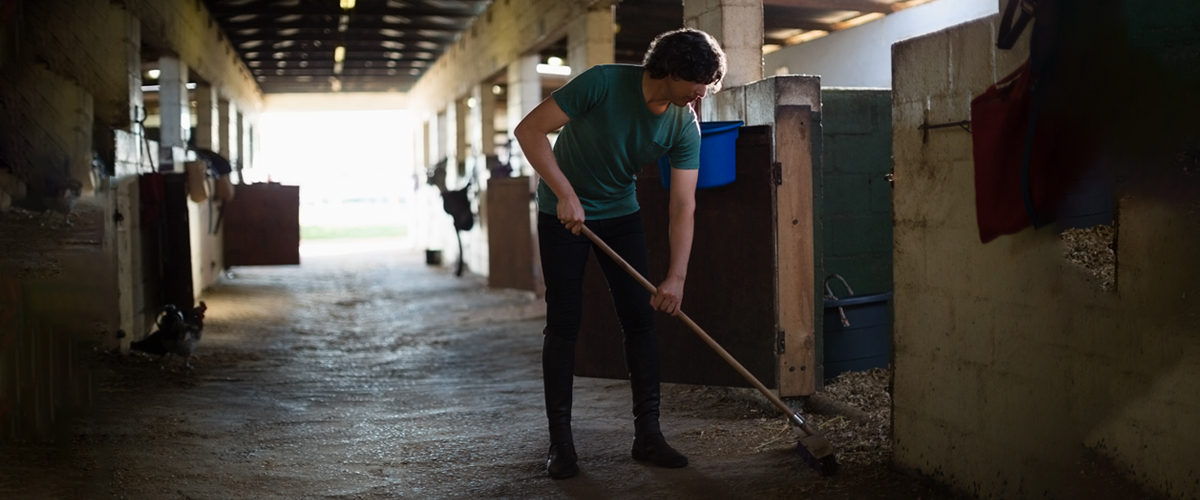Home » Stable floor
Stable floor
- Publicatie datum January 30, 2024
- Auteur Joost van Hulst
- Laatst aangepast January 30, 2024
 800
800 The stable floors from ICM Projects are designed with an eye for quality, durability and meet the strictest requirements. Whether it concerns an agricultural stable or an industrial application, we supply custom floors that meet the specific needs of your company.
But how do you select a suitable stable floor for your specific application and what should you pay attention to? We are happy to tell you more about the important matters regarding stable floors, so that you find one that perfectly meets your needs.
What are important properties for a stable floor?
A stable floor must meet several important properties to deliver optimal performance:
- Non-slip: To ensure the safety of people and animals, a non-slip surface is essential.
- Wear resistance: stable floors are used intensively. That is why they must be resistant to wear and tear, for example when moving animals.
- Low-emission: to minimize environmental impact, a low-emission stable floor is necessary.
- Easy to maintain: a stable floor must be easy to clean to ensure a hygienic environment.
- Chemical resistant: the floor must be resistant to the chemicals commonly found in agricultural environments.
Which legal requirements must stable floors meet?
From 2012 onwards, new construction will require the installation of a low-emission floor if one wants to qualify for the Sustainable Livestock Farming Measure, which makes tax subsidies possible. In addition, stable floors must comply with the type of stable floors mentioned in the Ammonia and Livestock Farming Regulations.
Ammonia and Livestock Farming Regulations
The ‘Ammonia and Livestock Farming Regulations’ (RAV) is a Dutch regulation that determines the ammonia emissions from various housing systems for livestock farms. This scheme is intended to reduce the environmental impact of livestock farming and improve air quality.
Stable floors are an important part of the stable systems because they influence the amount and speed at which the animals’ urine and manure are removed. The faster the urine and manure are separated, the less ammonia is released.
The RAV sets requirements for various aspects of livestock farms, including stable floors. These requirements are intended to limit ammonia emissions.
Standard for Sustainable Livestock Farming
The Sustainable Livestock Farming Maatlat (MDV) is a certification system for livestock stables that contribute to the sustainability of livestock farming. An MDV stable is a livestock stable with a lower environmental impact and measures for animal health and welfare.
These stables meet strict sustainability requirements on the themes of ammonia emissions, company & environment, fire safety, animal health, animal welfare, particulate matter and climate. A suitable stable floor contributes to this.
It is important to note that from 2012 onwards, new construction will require the installation of a low-emission floor if one wants to qualify for the Sustainable Livestock Farming Standard.
Which floors meet the requirements of a stable floor?
Rubber floors
Rubber floors are excellent for stables. They provide a comfortable and non-slip surface for animals. In addition, they are wear-resistant and easy to clean, which means they meet the most important requirements for a stable floor.
Trowel floors
Trowel floors are seamless floor systems that consist of several layers of resins and fillers. They are strong, chemical resistant and easy to clean. Trowel floors therefore meet the high demands placed on stable floors.
Methyl methacrylate floors
Methyl methacrylate floors (MMA floors) are particularly suitable for situations where speed is essential. They have a fast curing time and can be loaded immediately. In addition, they are anti-slip and chemically resistant, which makes them suitable for use in a stable
For which applications are high-quality stable floors essential?
Stable feeds can be widely used. Many companies that keep livestock have to deal with daily emissions of ammonia, which can be limited by using a suitable stable floor. Some applications in which stable floors can provide a solution are:
- Dairy farms
- Horse farms
- Pig farms
- Poultry farms
- Horse riding schools
- Petting zoos
Choose customization: choose a stable floor from ICM Projects
At ICM Projects we specialize in providing tailor-made stable floor solutions that meet the highest standards of quality and sustainability.
Whether you are looking for a rubber, trowel or MMA floor, we have the expertise and knowledge to meet all your specific needs. Contact us today to find out how we can help you create the perfect environment for your livestock.
Is a low-emission floor necessary in a stable?
Yes, from 2012 it will be necessary for new construction to install a low-emission floor if you want to meet the applicable legal requirements and qualify for the ‘Sustainable Livestock Farming Standard’. ICM Projects supplies low-emission stable floors that meet all requirements.
How long does it take to install a stable floor at ICM Projects?
The duration of installing a stable floor depends on various factors, such as the size of the project and the type of floor that is chosen. Our experts can advise you on this and make a realistic assessment.
How much does a stable floor cost at ICM Projects?
The costs of a stable floor vary depending on various factors, including the type of floor chosen, the surface area and any additional options. Contact our advisors for a tailor-made quote without obligation.
OVER DE AUTEUR
Purchasing a company floor does not happen overnight. A good floor is only the basis for high work performance if you and your colleagues function optimally in it. For that simple reason, CEO Joost van Hulst makes sure every project runs smoothly every day. We get to the bottom of things for our clients. From administrative offices to hospitals. Ready to perform? The floor is yours.